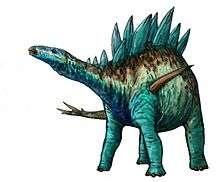Texasetes
| Texasetes Temporal range: Early Cretaceous, 100 Ma | |
|---|---|
| Scientific classification | |
| Kingdom: | Animalia |
| Phylum: | Chordata |
| Class: | Reptilia |
| Clade: | Dinosauria |
| Order: | †Ornithischia |
| Suborder: | †Ankylosauria |
| Family: | †Nodosauridae |
| Genus: | †Texasetes Coombs, 1995 |
| Species: | †T. pleurohalio |
| Binomial name | |
| Texasetes pleurohalio Coombs, 1995 | |
Texasetes (meaning "Texas resident") is a genus of ankylosaurian dinosaur from the late Lower Cretaceous of North America. This poorly known genus has been recovered from the Paw Paw Formation (late Albian) near Haslet, Tarrant County Texas, which has also produced the nodosaurid ankylosaur Pawpawsaurus. Texasetes is estimated to have been 2.5-3 meters (8-10 ft) in length.
Discovery and species
The holotype and only known specimen (USNM 337987) consists of portions of the scapulocoracoid and pelvis, elements from the fore- and hindlimbs, vertebrae, osteoderms, a skull fragment, and one tooth. These remains had been labelled as those of a sauropod in the collection of the Smithsonian Institution, but were many years later recognized as ankylosaurian by M.K. Brett-Surman. They were subsequently studied by ankylosaur expert Walter Preston Coombs Jr, who named them in 1995 as the type species Texasetes pleurohalio. Vickaryous et al. (2004) and Coombs (1995) describe Texasetes as having a horizontally oriented ilium, an imperforate acetabulum, and "characteristically ankylosaur scapula morphology, including a prominent acromion and prespinous fossa."
Classification
However, Lee (1996) has questioned whether this material is diagnostic and suggests Texasetes is likely a synonym of Pawpawsaurus. Coombs assigned the specimen to the family Nodosauridae, but Vickaryous et al. consider it Ankylosauria incertae sedis.
See also
References
- Coombs, W. P. 1995. A nodosaurid ankylosaur (Dinosauria: Ornithischia) from the Lower Cretaceous of Texas. Journal of Vertebrate Paleontology 15(2):298-312.
- Lee, Y.-N. 1996. A new nodosaurid ankylosaur (Dinosauria, Ornithischia) from the Paw Paw Formation (late Albian) of Texas. Journal of Vertebrate Paleontology 16:232-245.
- Vickaryous, Maryanska, and Weishampel 2004. Chapter Seventeen: Ankylosauria. in The Dinosauria (2nd edition), Weishampel, D. B., Dodson, P., and Osmólska, H., editors. University of California Press.

